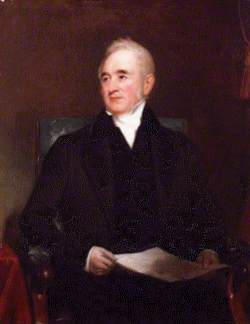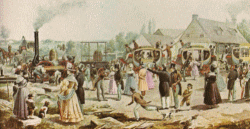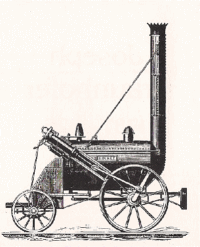 SKC Films Library SKC Films Library |
| SKC Films Library >> Technology >> Mechanical Engineering >> Biography |
| George Stephenson locomotive builder
George Stephenson was born in Wylam, Northumberland, on June 9, 1781, the second son of Robert Stephenson, a coal mine mechanic. He began his working career while still a boy, working first as a cowherd, and then as the driver of a gin horse at a colliery. By the time he was 14 he had worked his way up to assistant fireman, and at 17 he was put to work operating a Newcomen steam engine. Stephenson's father could not afford to send him to a formal school, so George enrolled at night schools so he could learn reading, writing, and arithmetic while working full time. In 1802 he married Frances Henderson, and his only son, Robert, was born the following year. In 1804 he became a mechanic at Killingworth Colliery. Frances died in 1806, leaving George to bring up Robert alone. Determined that Robert would get the education he had been denied, George spent his spare time repairing neighbors' clocks and watches, mending and making shoes, and cutting cloth for work suits to raise enough money to send Robert to school in Newcastle. Robert took full advantage of the opportunity his father gave him, and often brought home material relating to engineering for his father to study. The Locomotive Richard Trevithick, a Cornish mine engineer, demonstrated the world's first locomotive, the New Castle, in 1804. Designed to carry coal from mines to ironworks, the locomotive proved too heavy for existing rails, however, and was never put into regular use. Improvements were made to Trevithick's design by subsequent inventors over the next several years, but every new version presented a new set of problems. Those problems included drive, suspension, and a strong and safe permanent track, but the primary difficulty was creating a speed faster than horses pulling an equivalent in loaded wagons. In his capacity as chief mechanic at Killingworth, Stephenson developed a reputation for being able to deal with difficult machinery. It was this ability that earned him a commission to build a locomotive for carrying coal out of the mines. Stephenson improved on current designs, and on July 25, 1814, he demonstrated the Blücher, which turned out to be the most successful "travelling engine" to date, capable of pulling 30 tons up a hill at 4 miles per hour. Like other machines of the day, the Blücher had two vertical cylinders let into the boiler, from the pistons of which rods drove the gears. It differed, however, in that the gears drove the flanged wheels instead of the rack pinions, making it the world's first locomotive whose traction relied solely on the contact between its flanged wheels and the rail. In 1815, Stephenson improved his design so that the connecting rods drove the wheels directly and the wheels were coupled together by a chain. Over the next five years Stephenson built a total of sixteen locomotives, most of them for Killingworth. He spent his spare time working on rail joints, tracks, axles, and improvements in economics of engine design. His next major breakthrough was development of the steam-blast technique, in which the waste steam is allowed to escape through a narrow pipe by way of the chimney, thus increasing the draft in the furnace considerably and opening up the possibility of a much faster travelling engine. In 1819, Stephenson was hired to build an eight-mile-long railroad from Hetton to the River Wear at Sunderland. The proposed route included some significant elevation changes, so Stephenson decided to lay the track out in sections. The first section was worked by locomotives, the next by fixed engines and cables. Then, at 250 feet above sea level, the coal wagons travelled down over two miles of self-acting inclined plane, followed by two miles of locomotive haulage. Once completed it became the first ever railway completely independent of animal power. In 1822, Stephenson was hired to be company engineer to the twelve-mile-long Stockton and Darlington Railway, which at that time was still in its planning stage. The following year he, along with son Robert and businessman Edward Pease, established The Robert Stephenson & Company in Newcastle-upon-Tyne to build the locomotives, the first company ever established for that purpose. The line officially opened on September 27, 1825, with Stephenson's Locomotion pulling the world's first passenger train a total of 37 miles at speeds of up to 12 miles per hour. the opening of the Stockton and Darlington Railway The first regular passenger train service was inaugurated by the Liverpool and Manchester Railway, for which Stephenson worked as an engineer. In October of 1829, the company held a competition over newly laid track at Rainhill to find the most suitable locomotive for its proposed service. For these trials, Stephenson built the Rocket, a locomotive which incorporated everything he had learned during the previous twenty years. The resulting design was truly revolutionary. Twenty-five tubes, each about three inches in diameter, ran at an angle from the firebox through the boiler shell. With a steam pressure of 40 pounds per square inch, it could travel 60 miles at 14 miles per hour (with a top speed of about 30 miles per hour), and it easily outstripped its two rivals. The railway formally opened on September 15, 1830, when eight brand new Stephenson-built locomotives left Liverpool, pulling trains carrying 600 guests. Stephenson continued to act as a consultant for major railroad enterprises for most of the rest of his life. In 1838, he bought Tapton House, a mansion near Chesterfield, Derbyshire. He subsequently bought part ownership in area coal mines, ironworks, and limestone quarries. He also experimented with stock breeding, new types of manure, and animal food, and developed a method of fattening chickens in half the usual time. His second wife, Elizabeth Hindley, died in 1845. He married a third time shortly before his death, which came on August 12, 1848. PRINT SOURCE WEB SOURCE SEE ALSO |
| SKC Films Library >> Technology >> Mechanical Engineering
>> Biography This page was last updated on June 08, 2017. |


